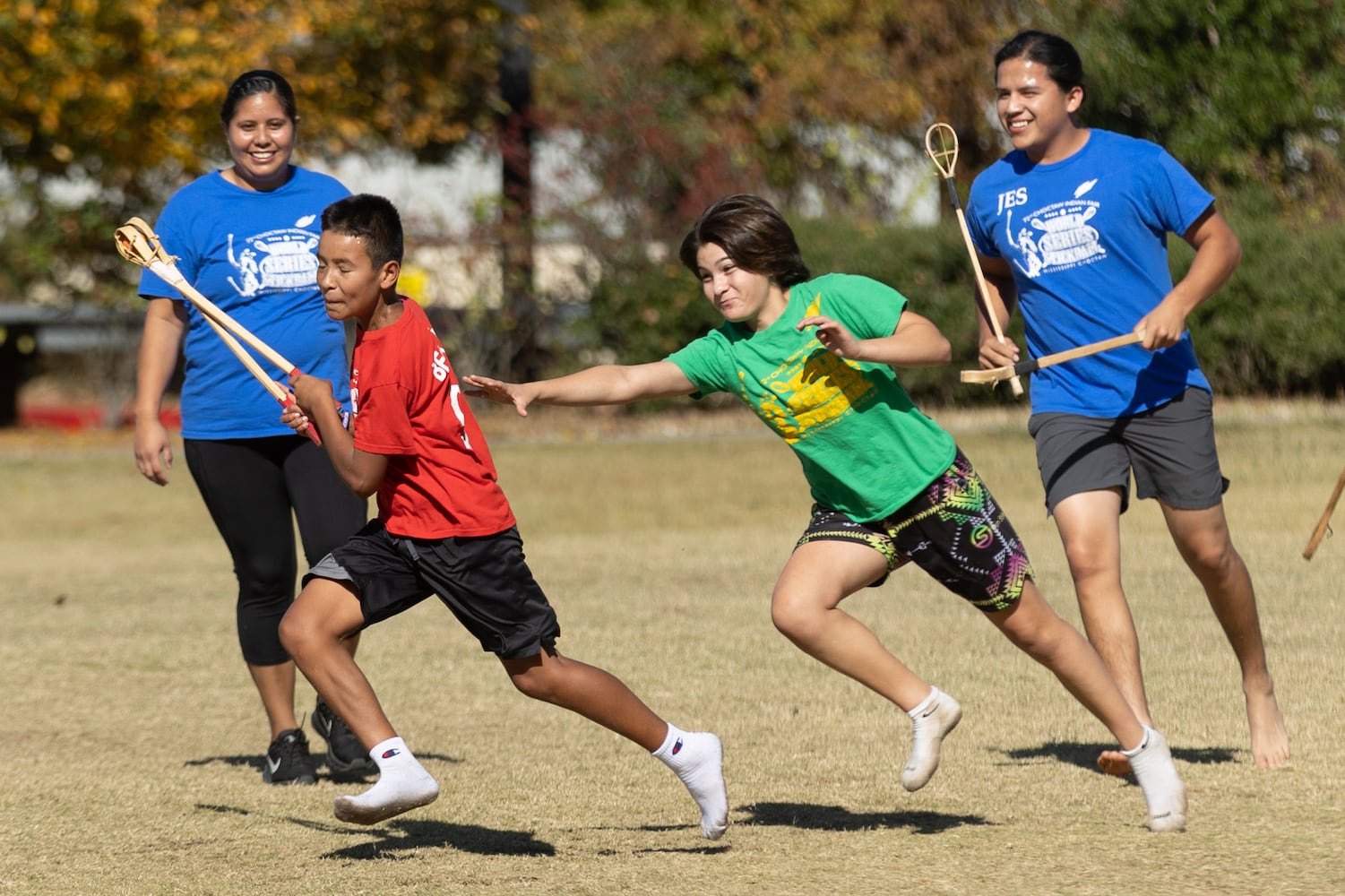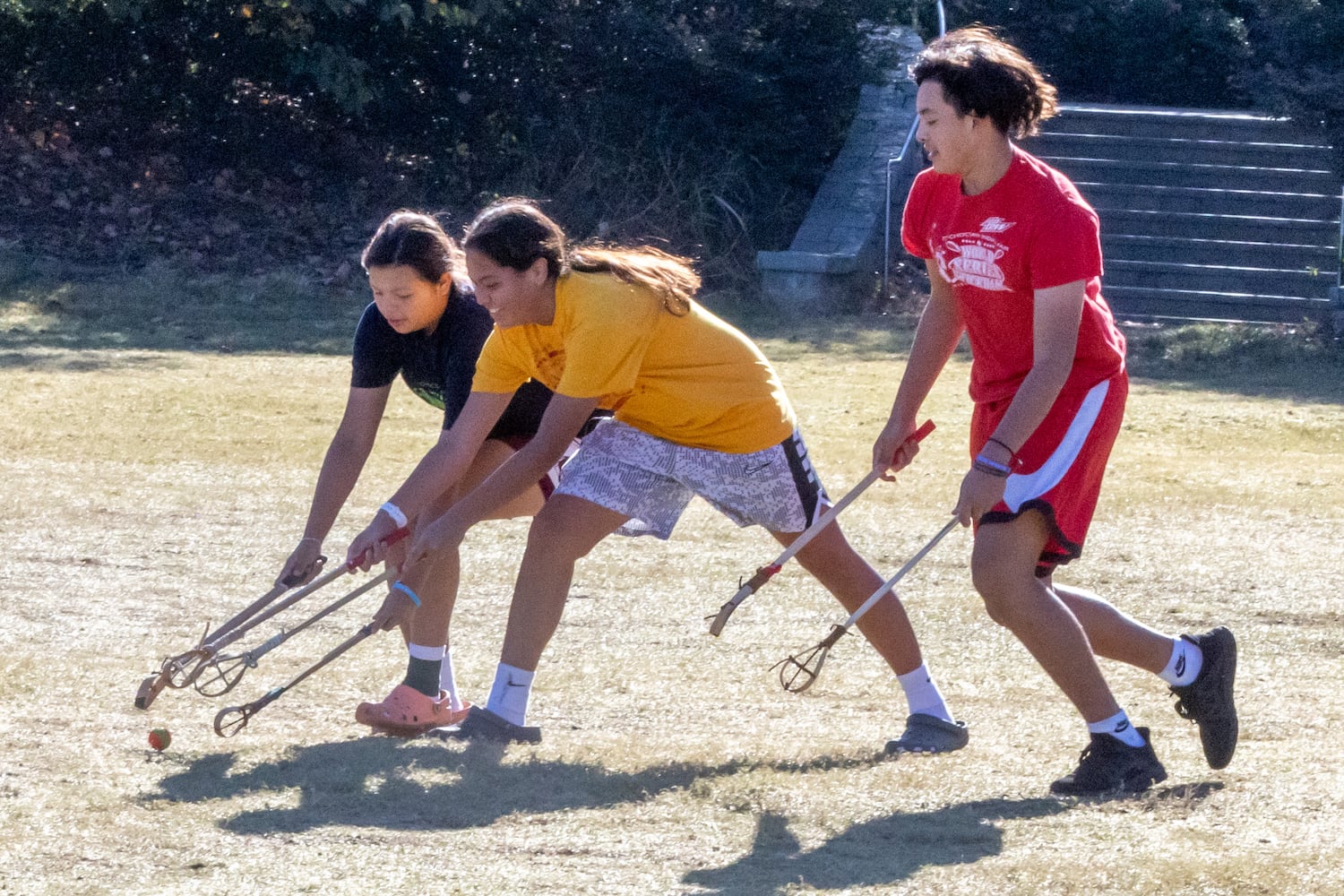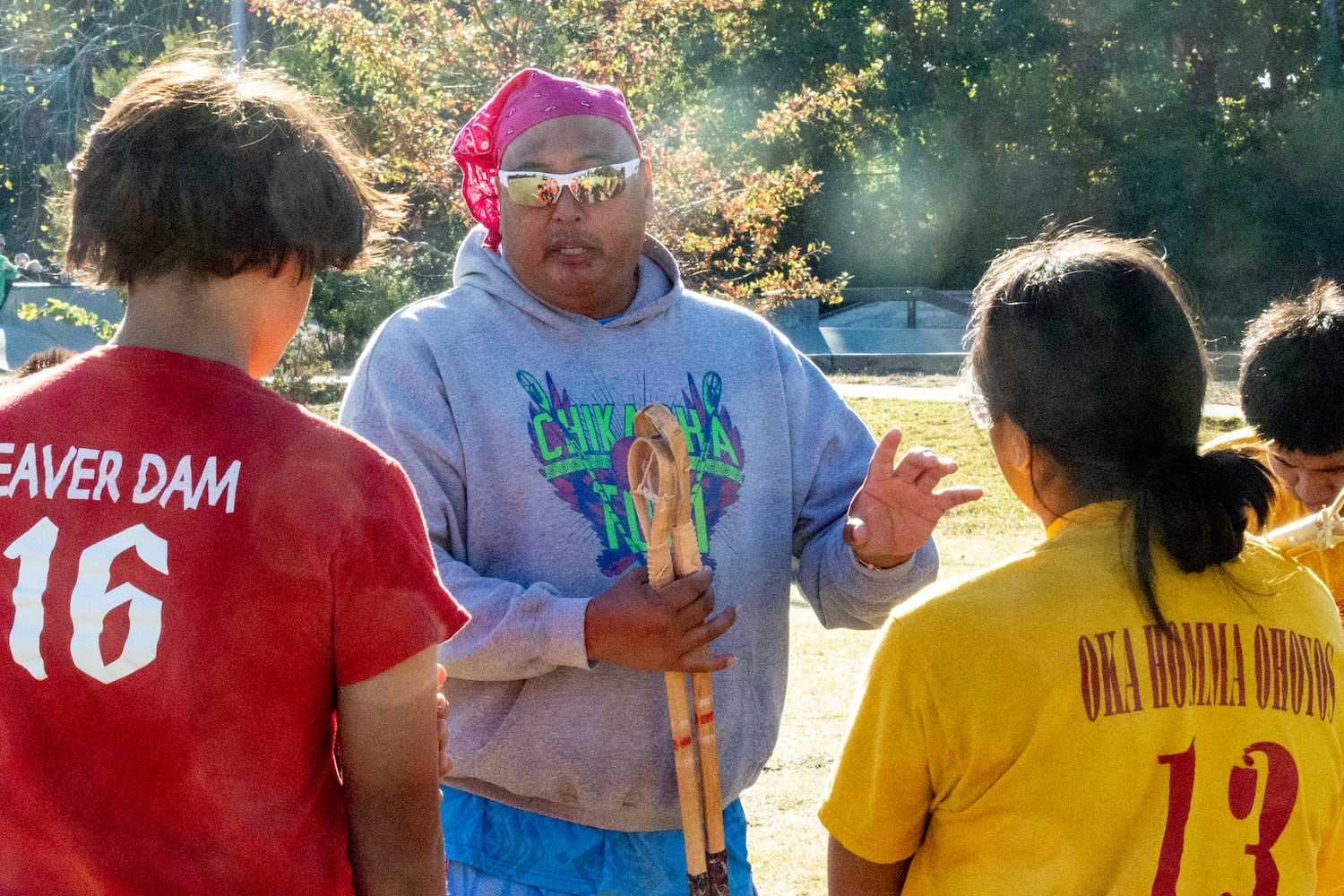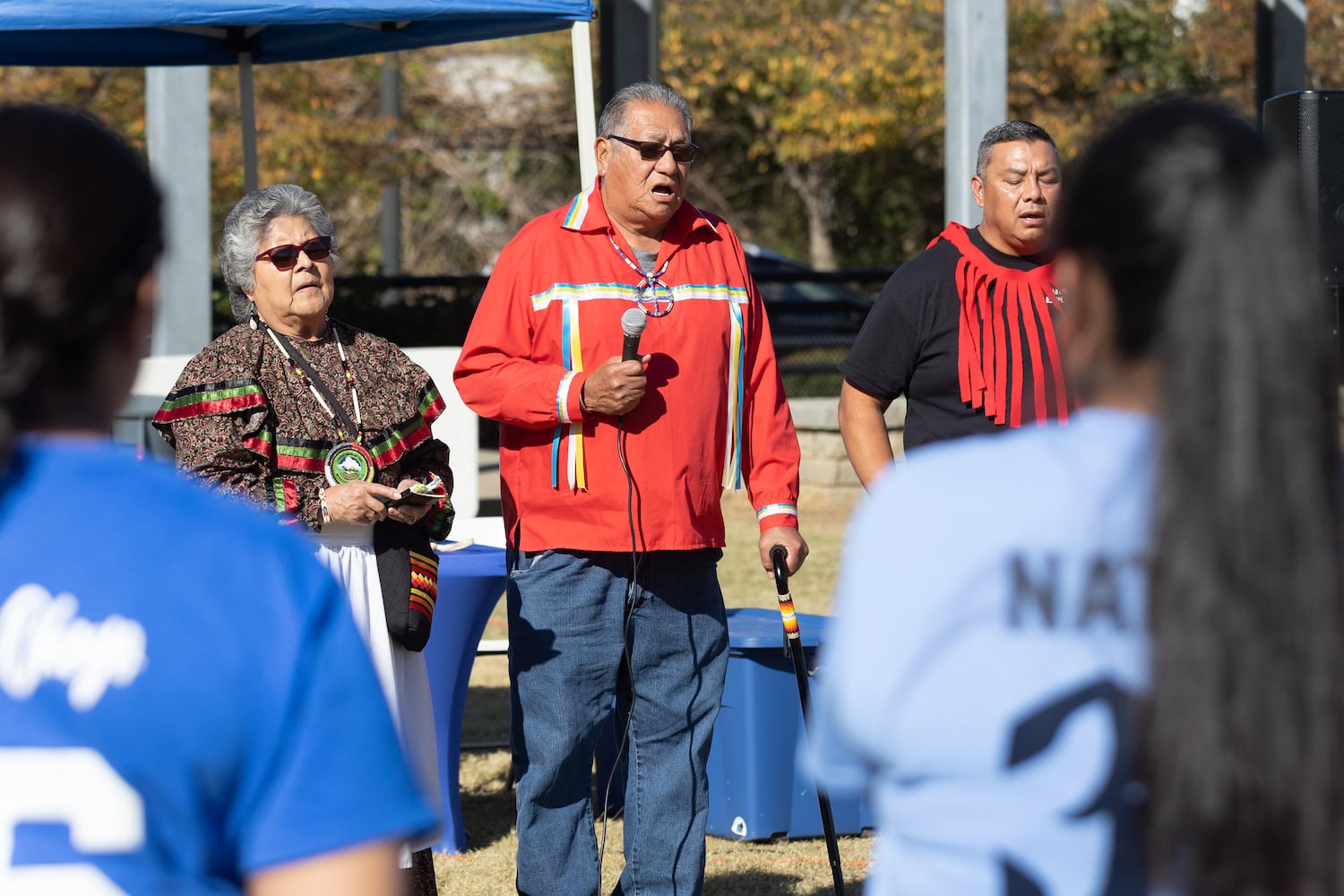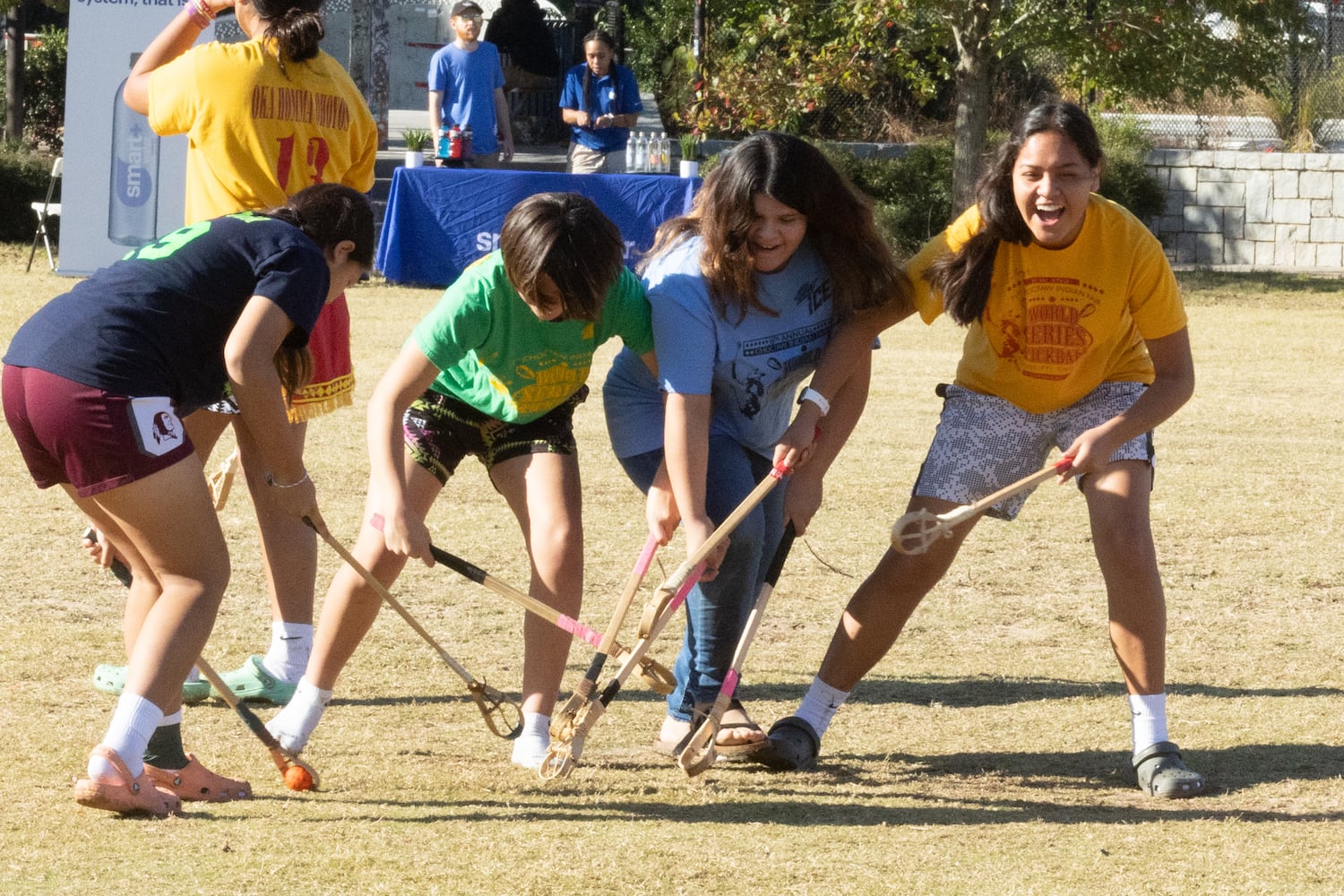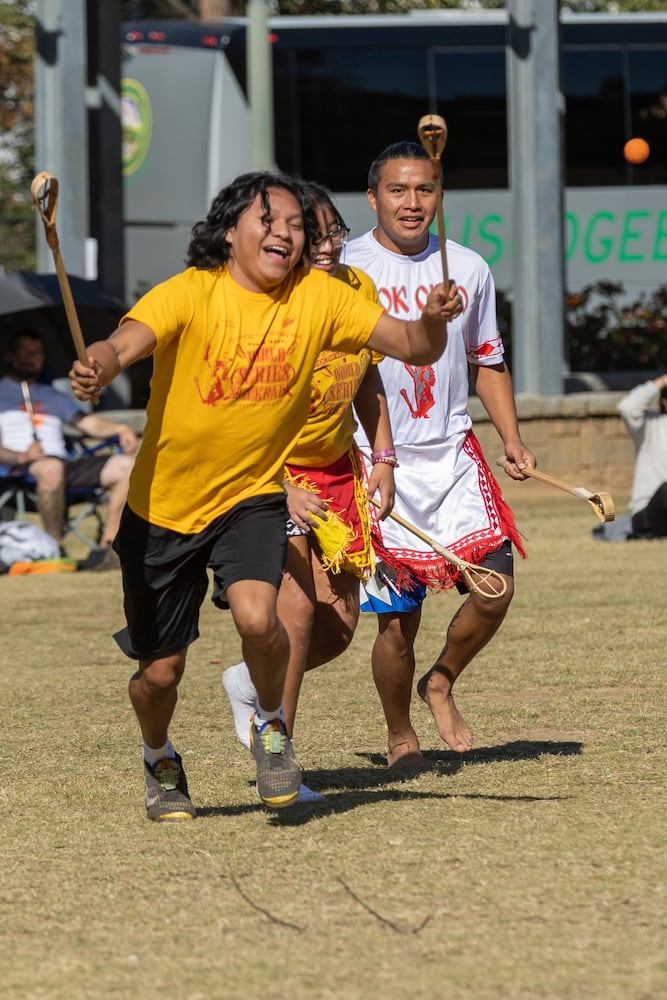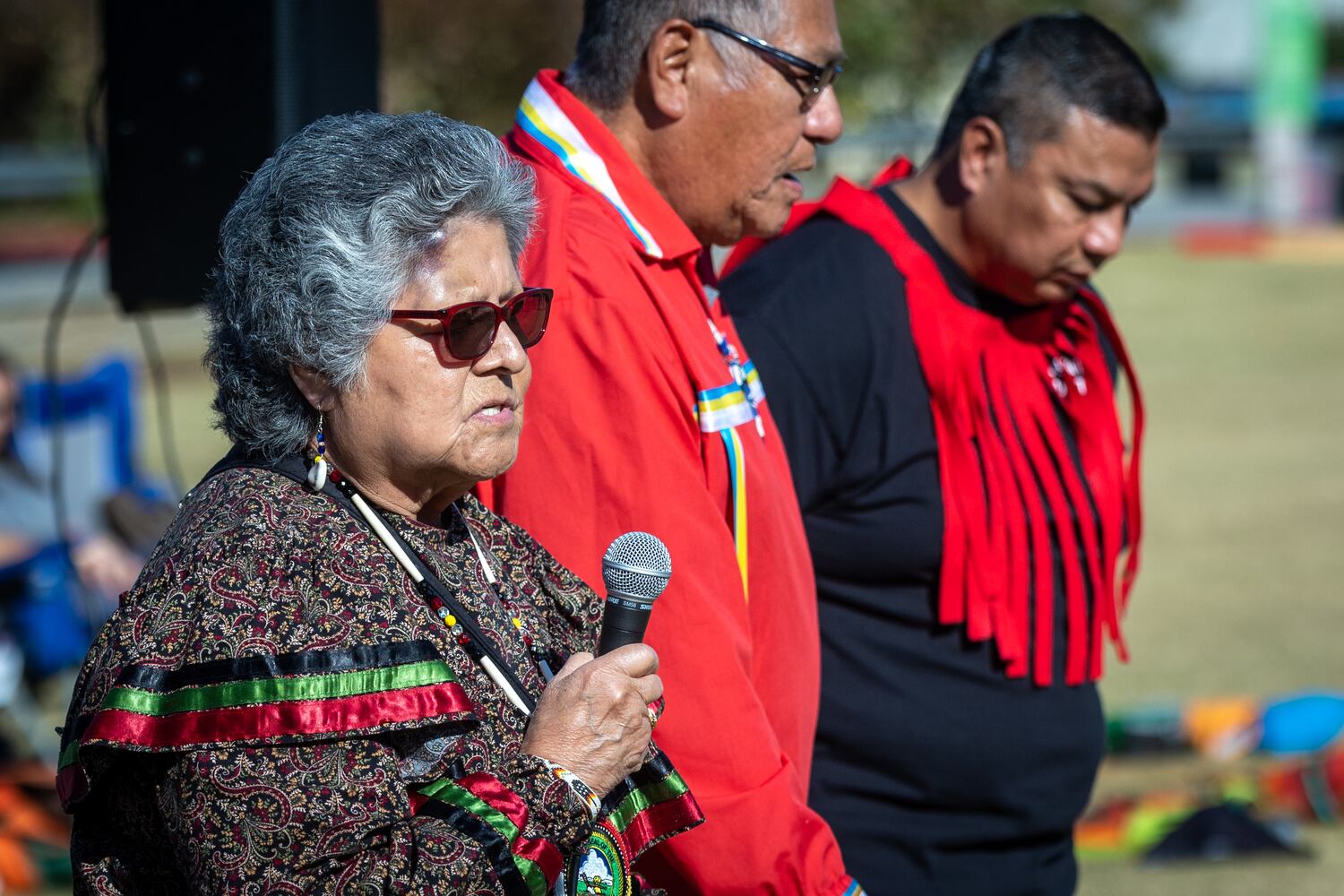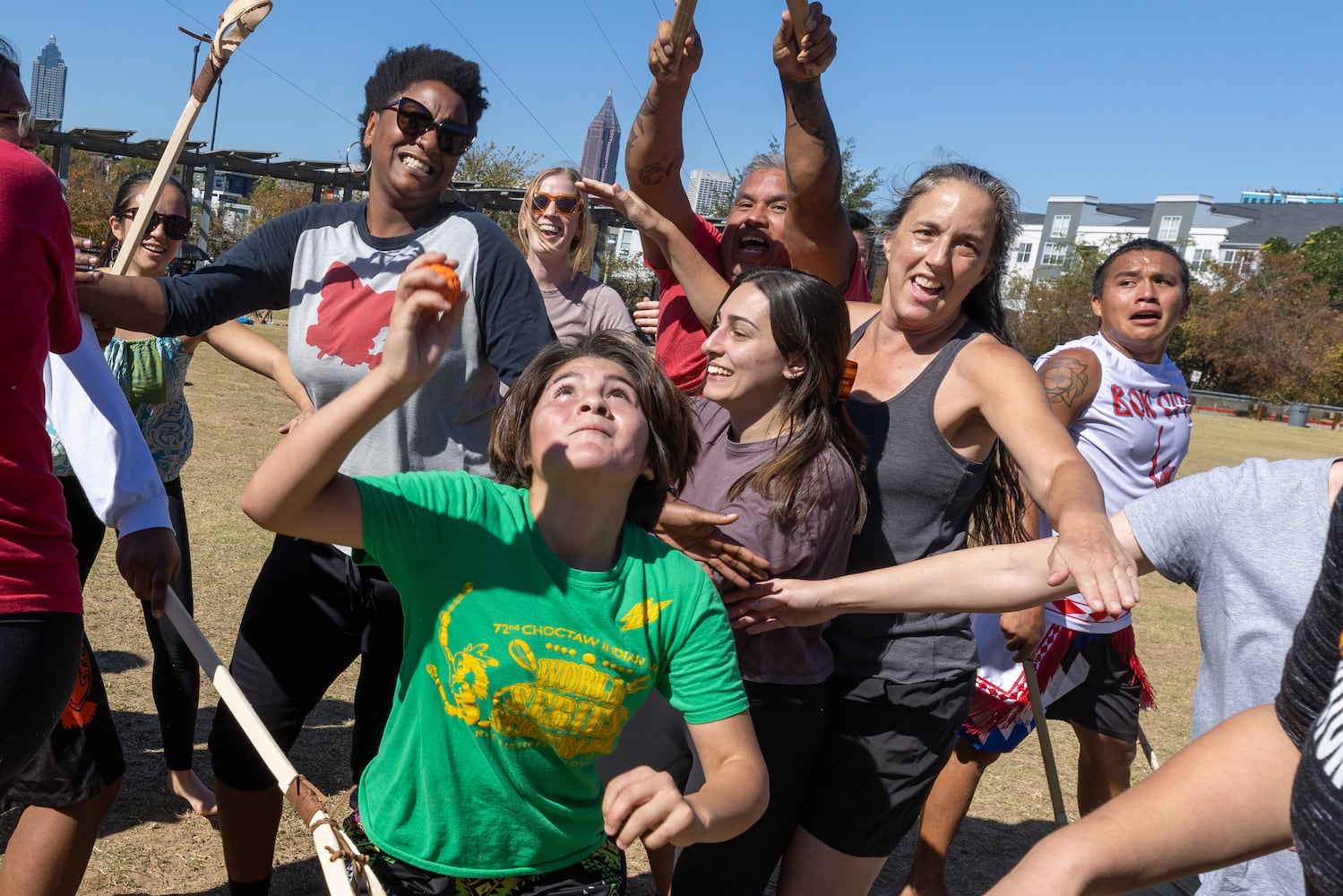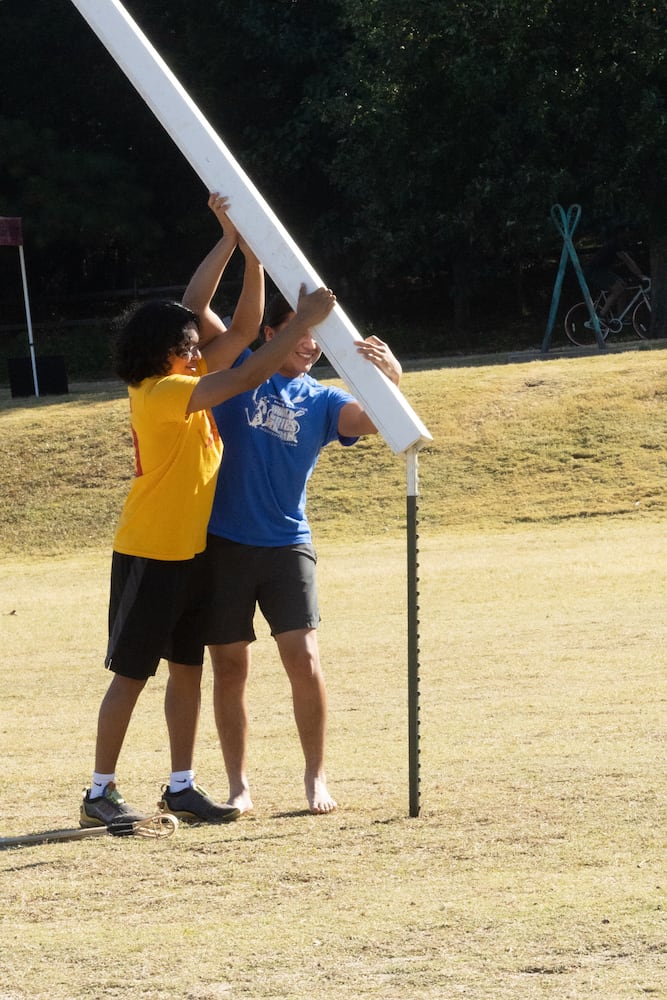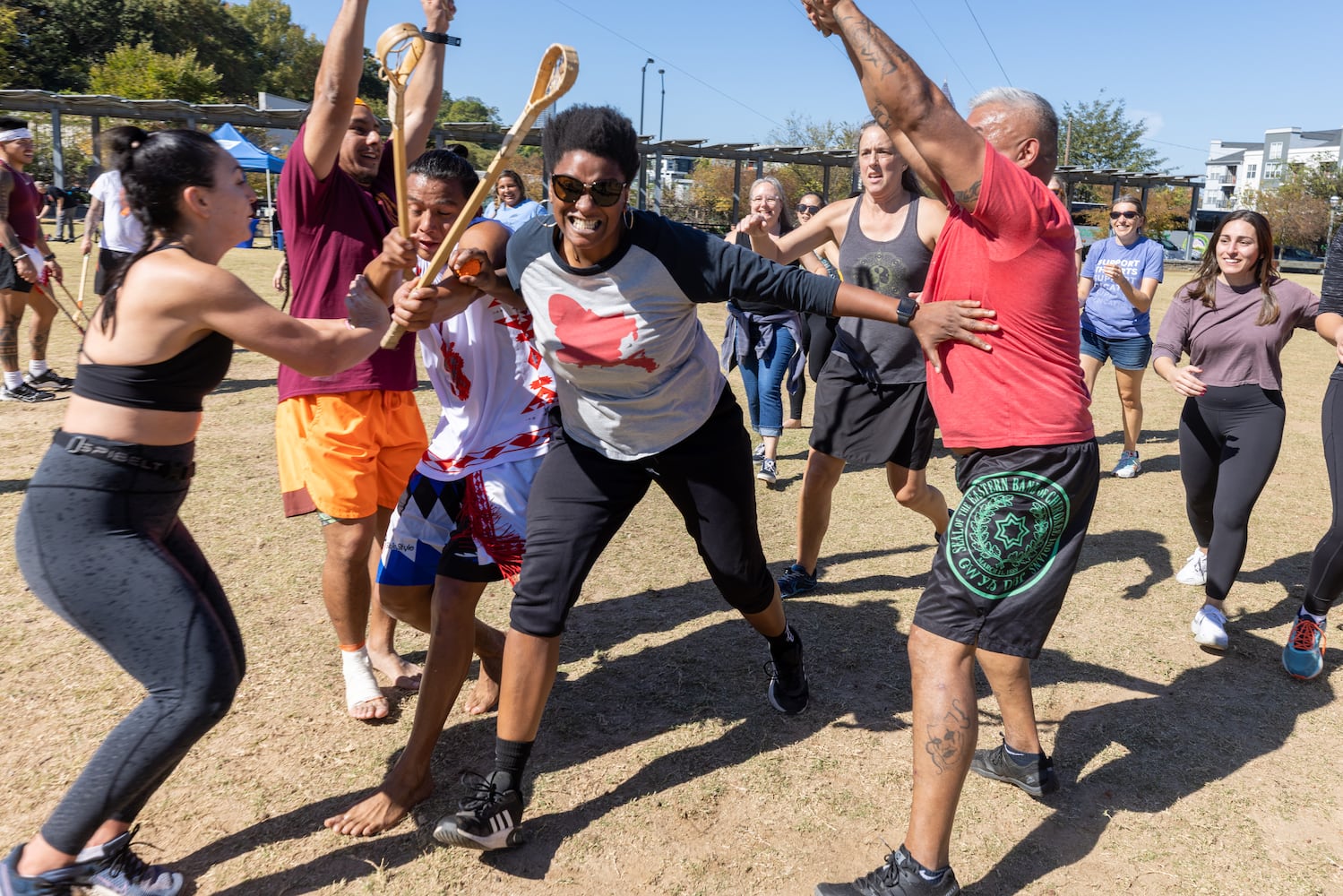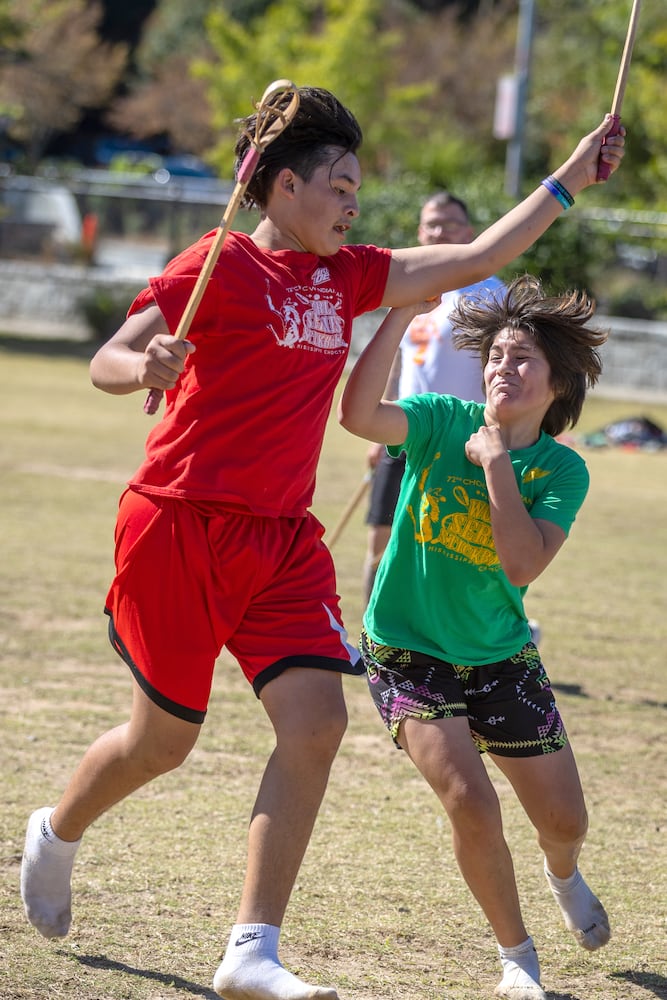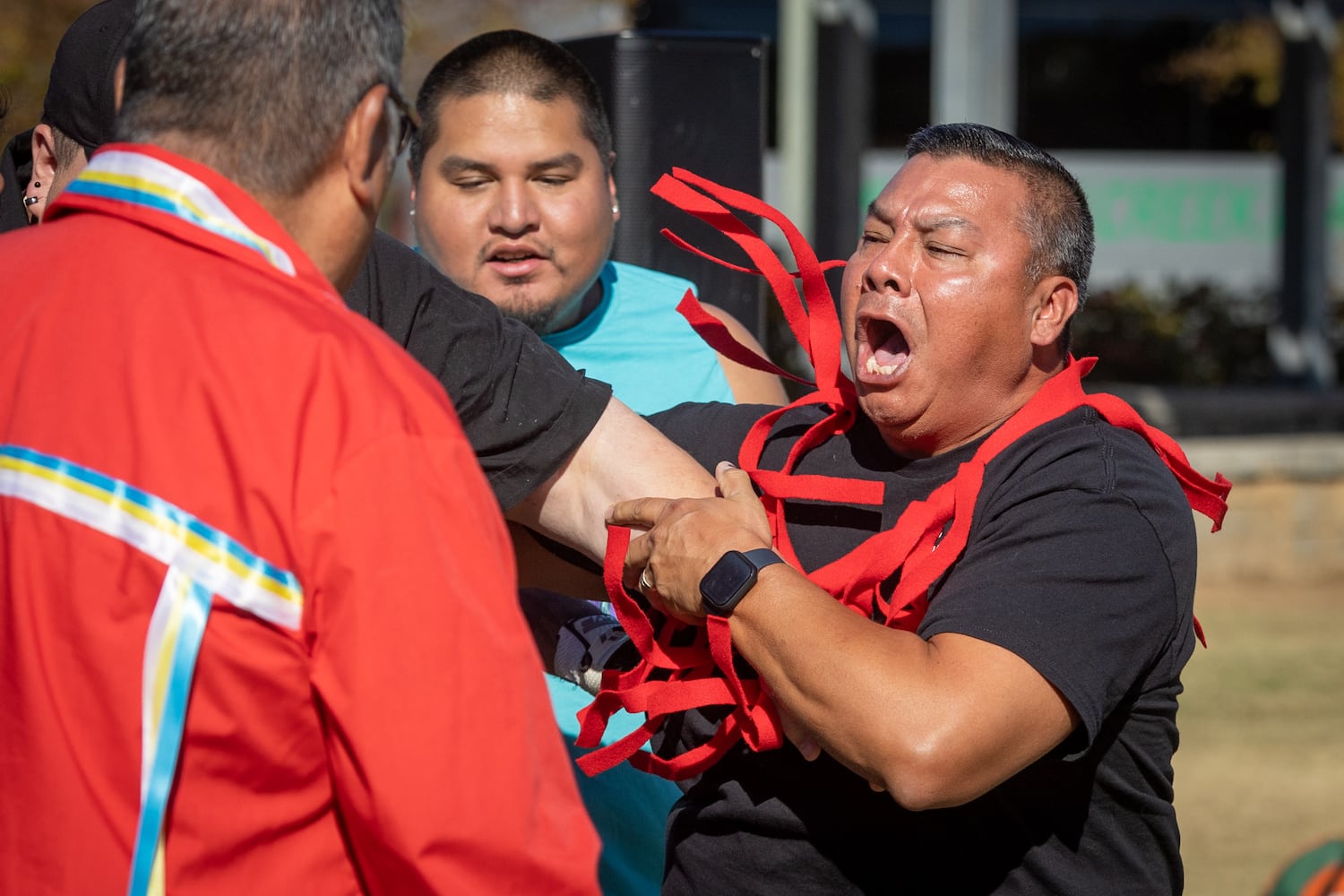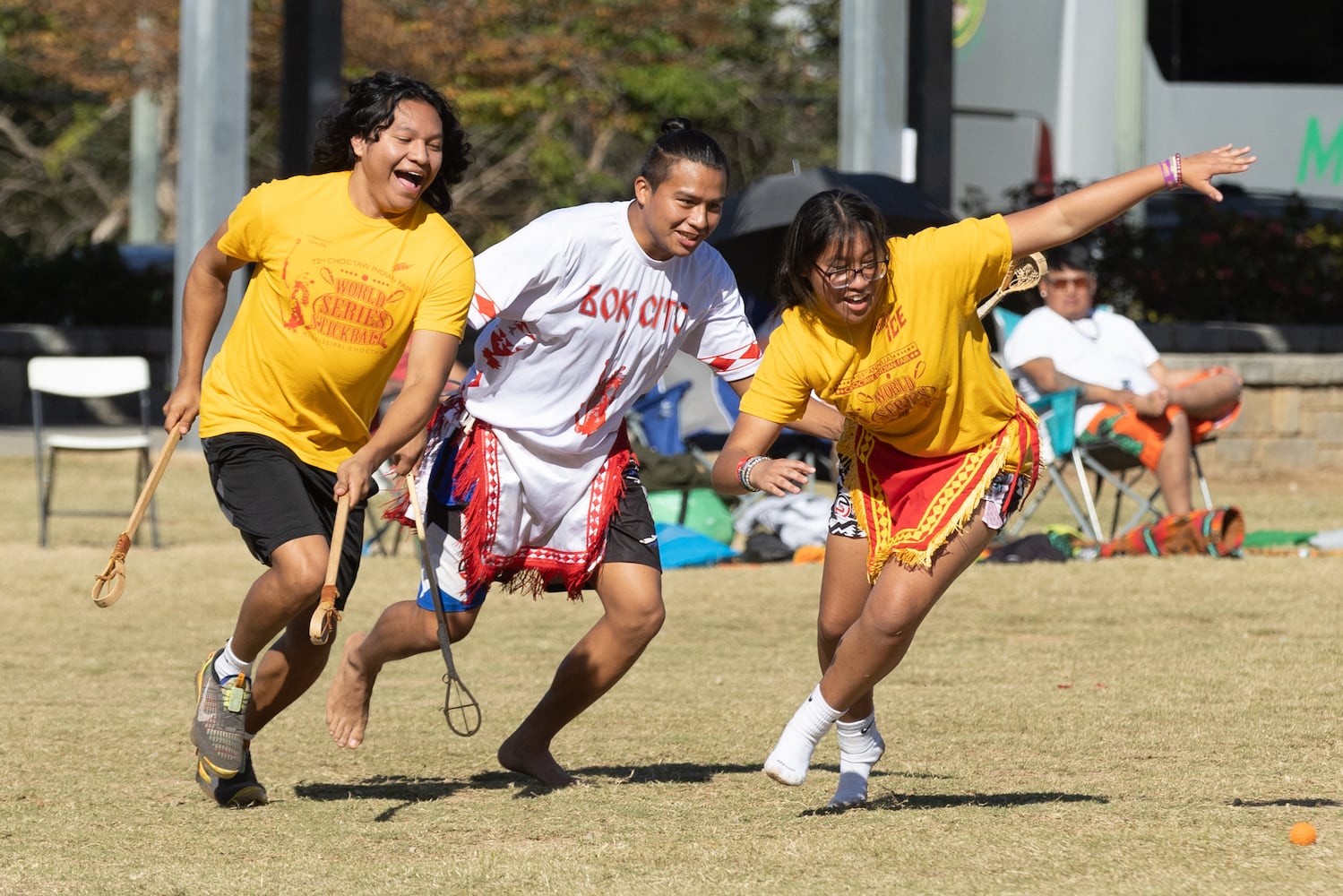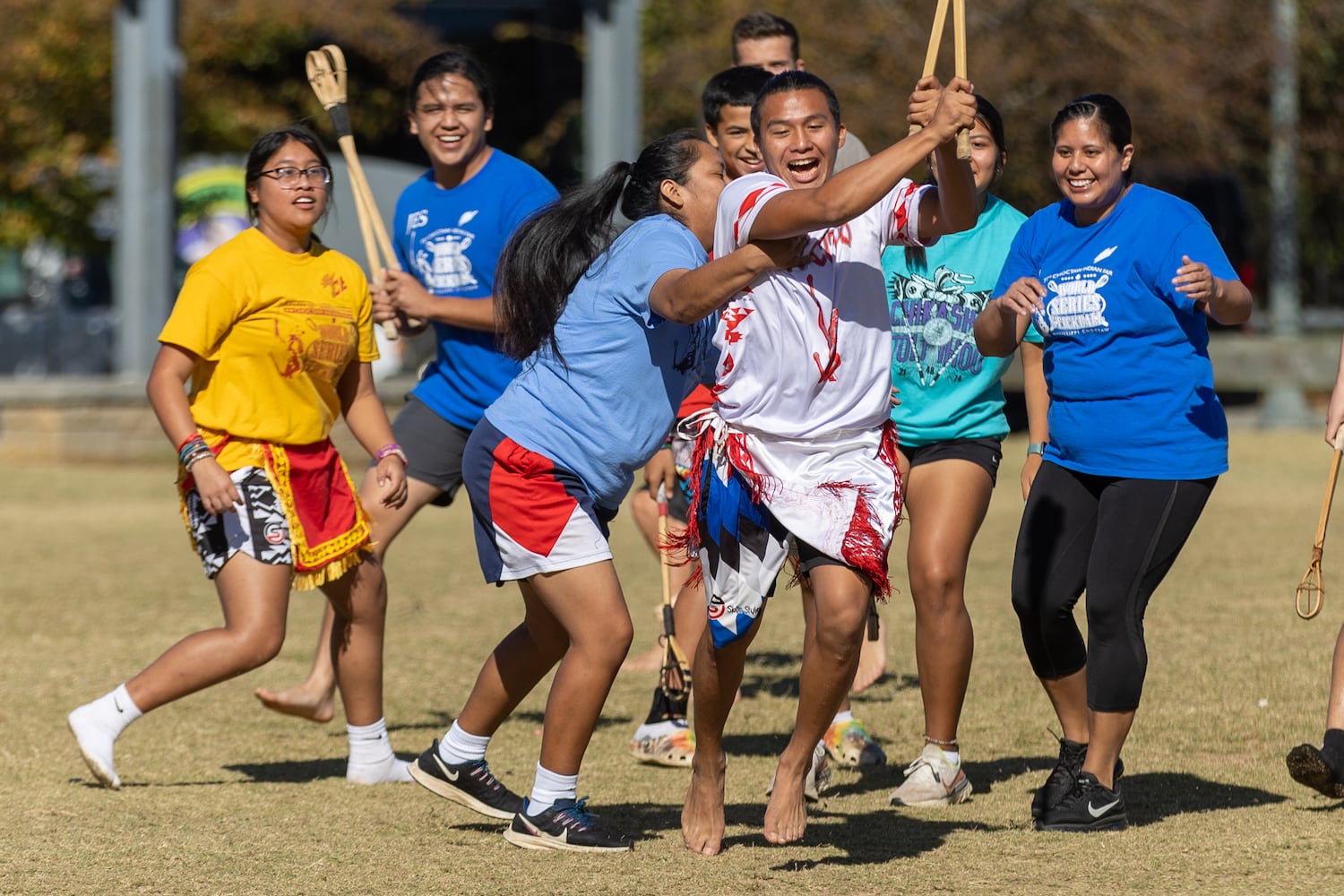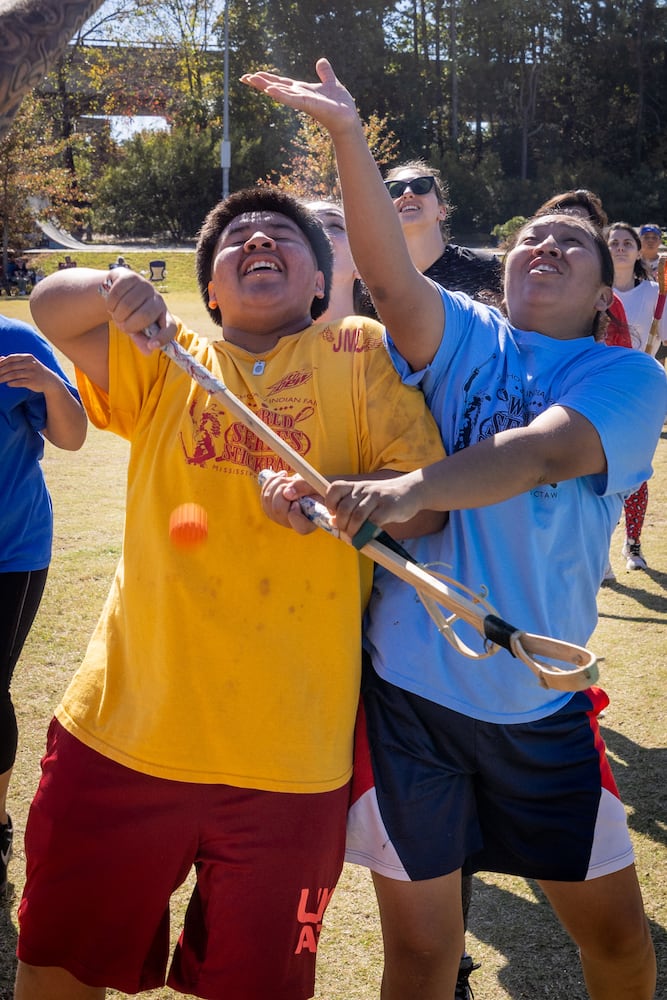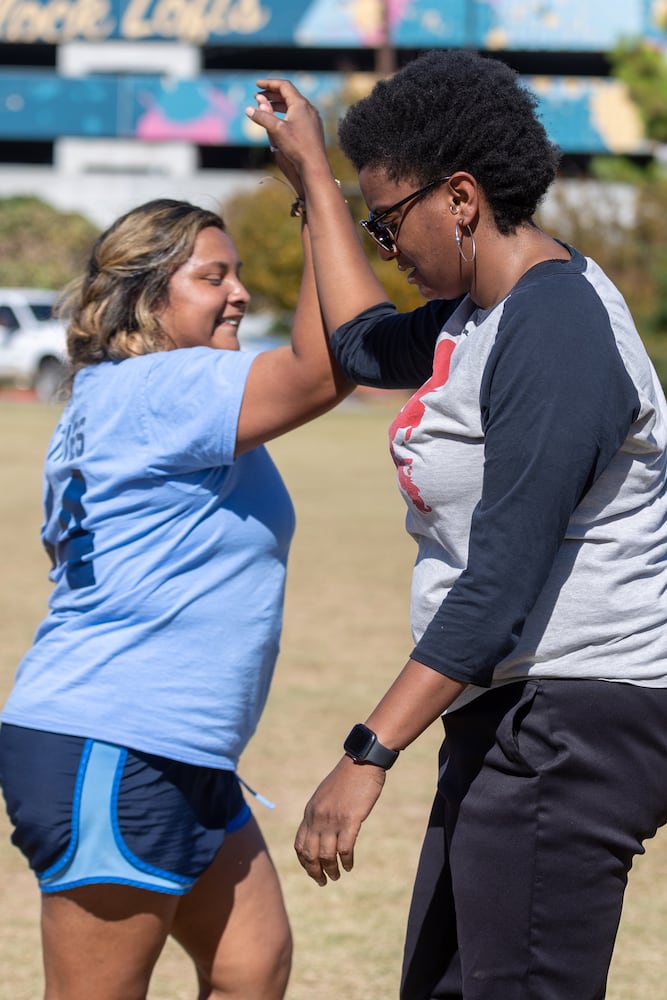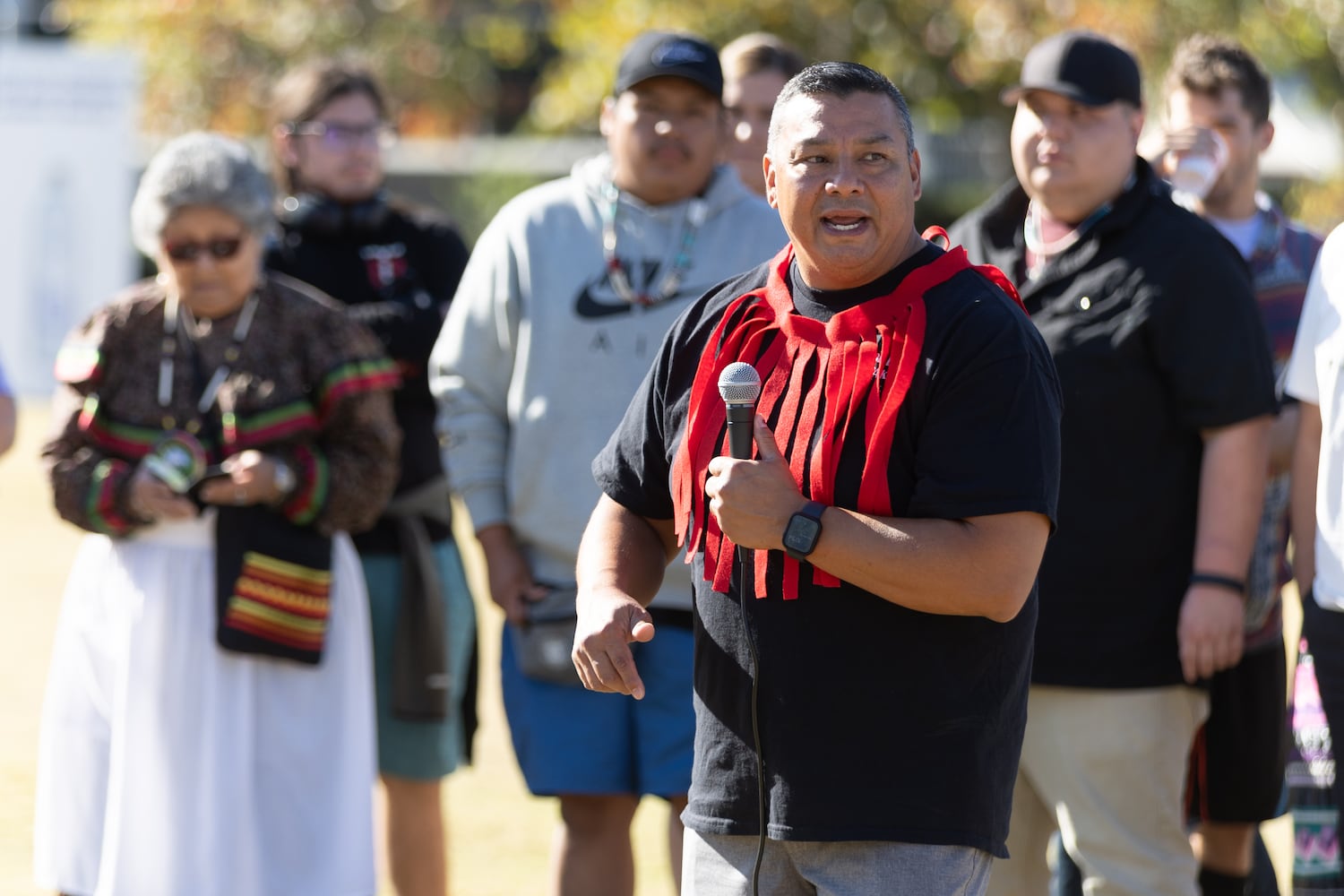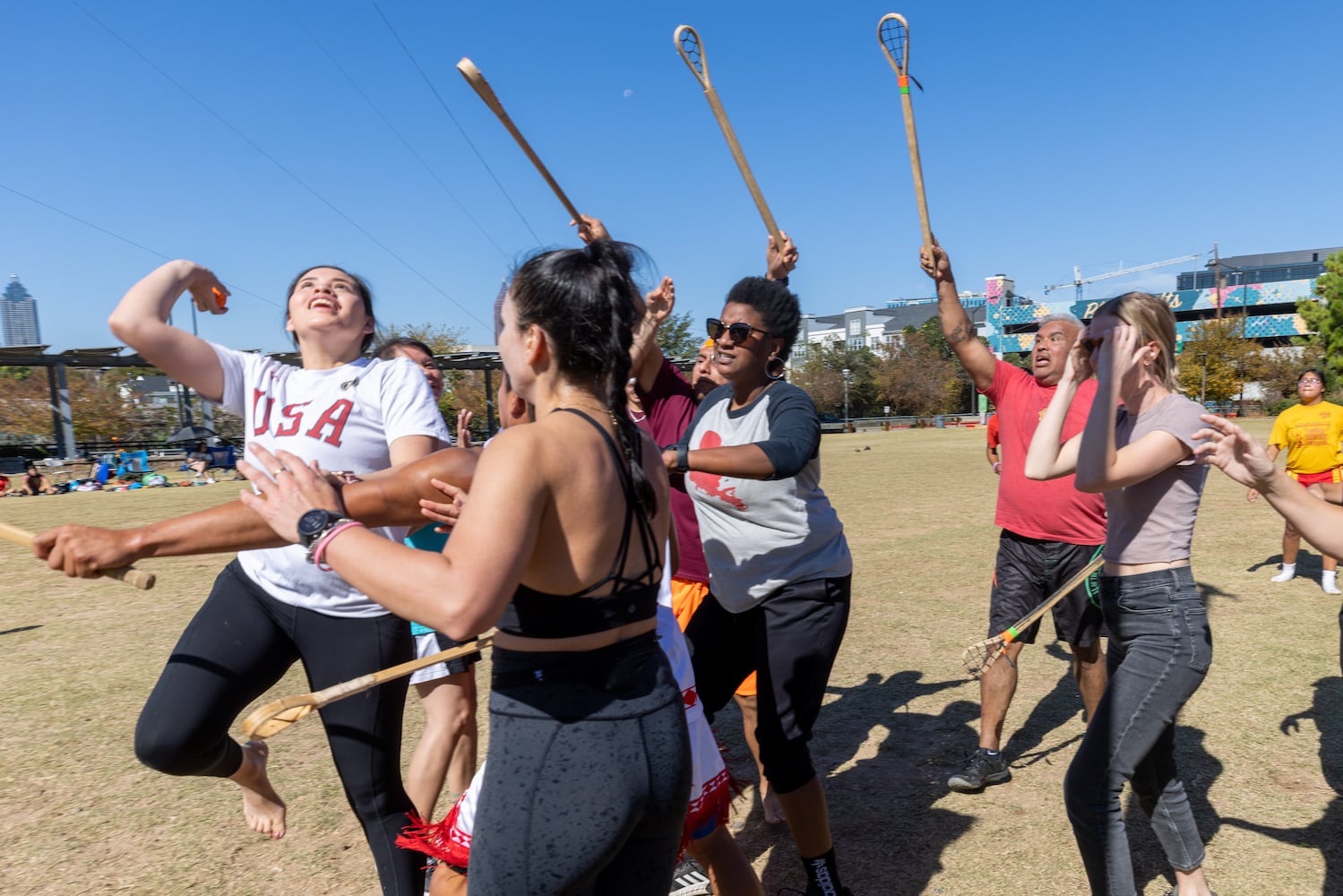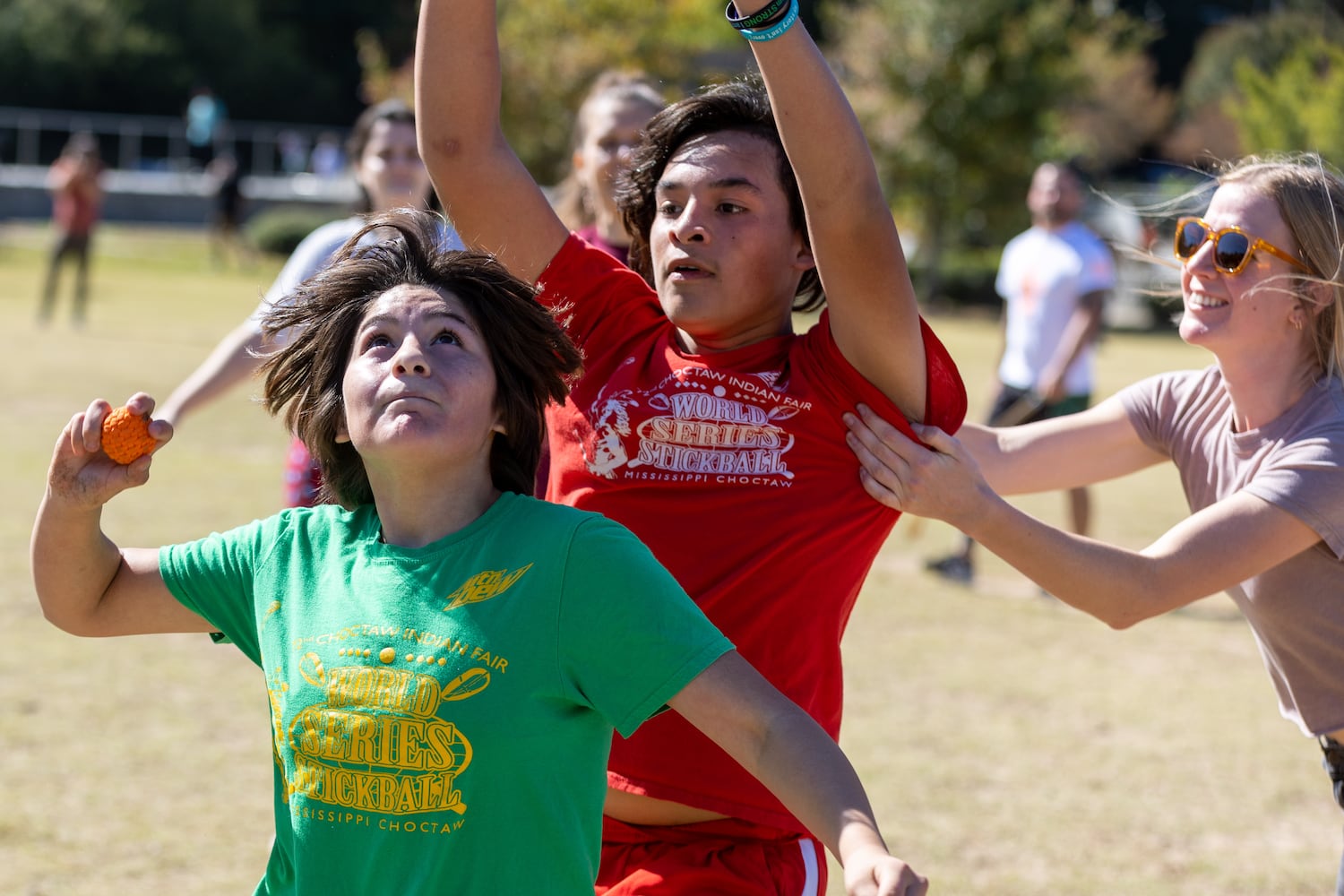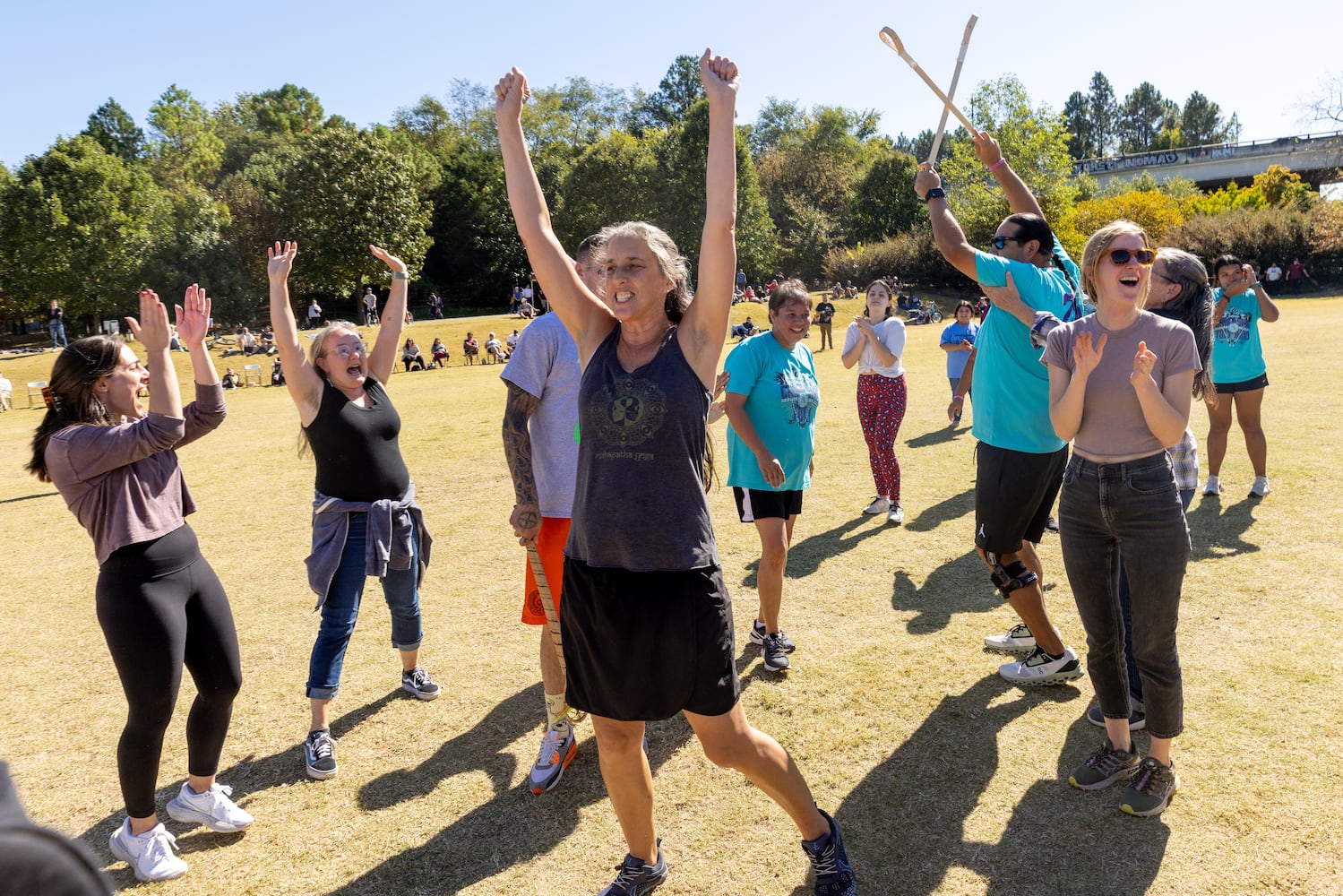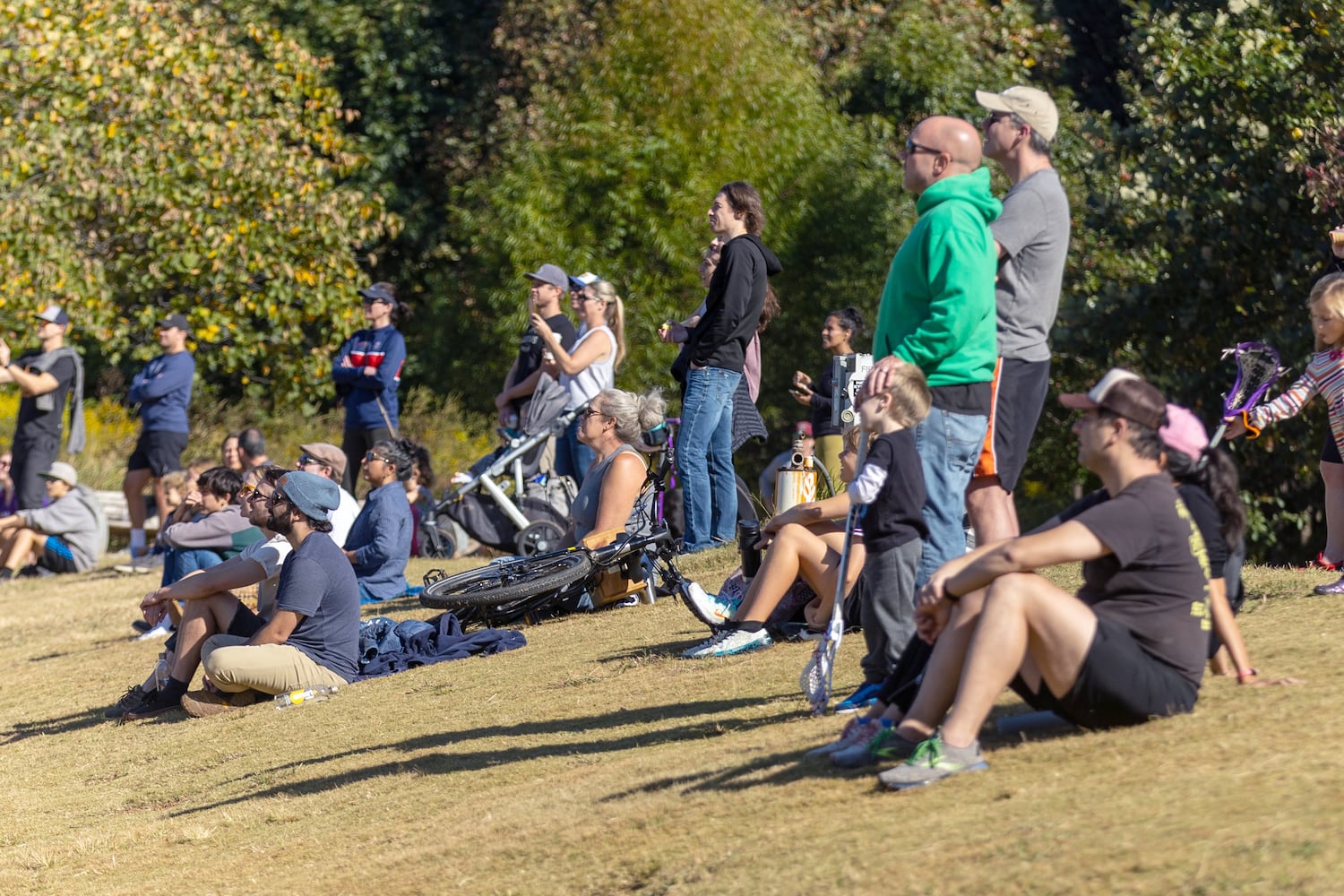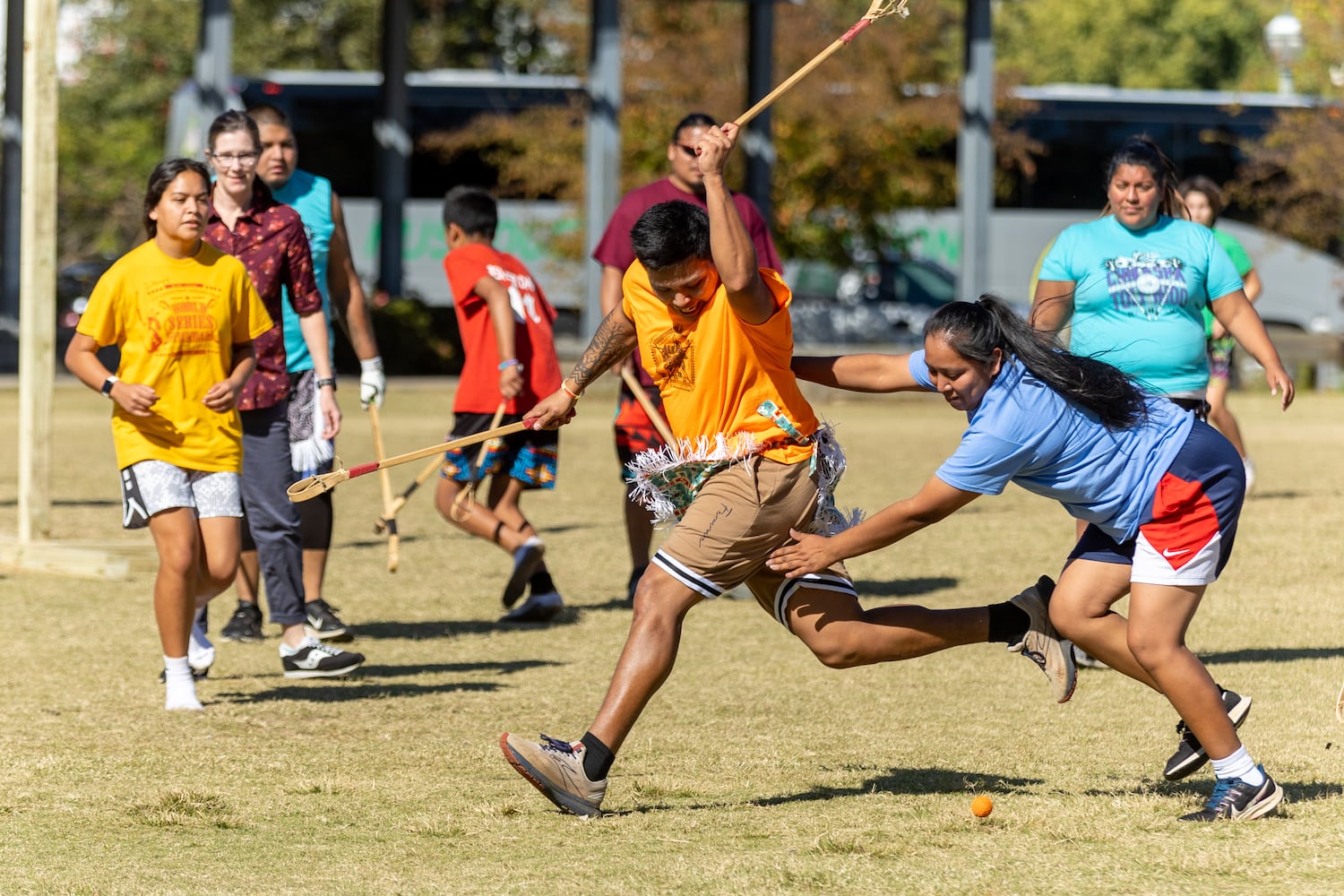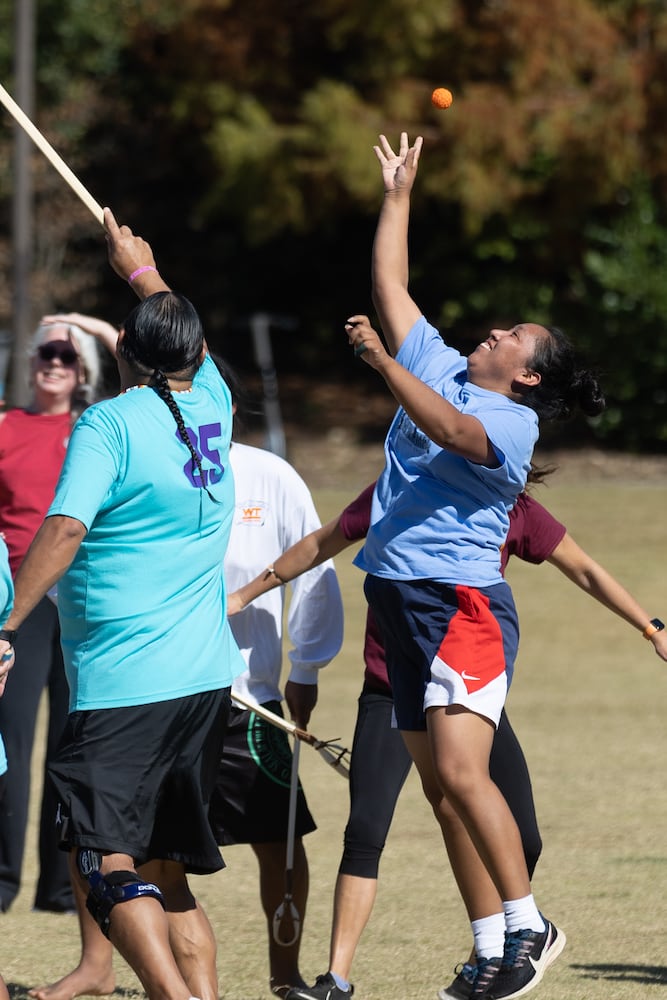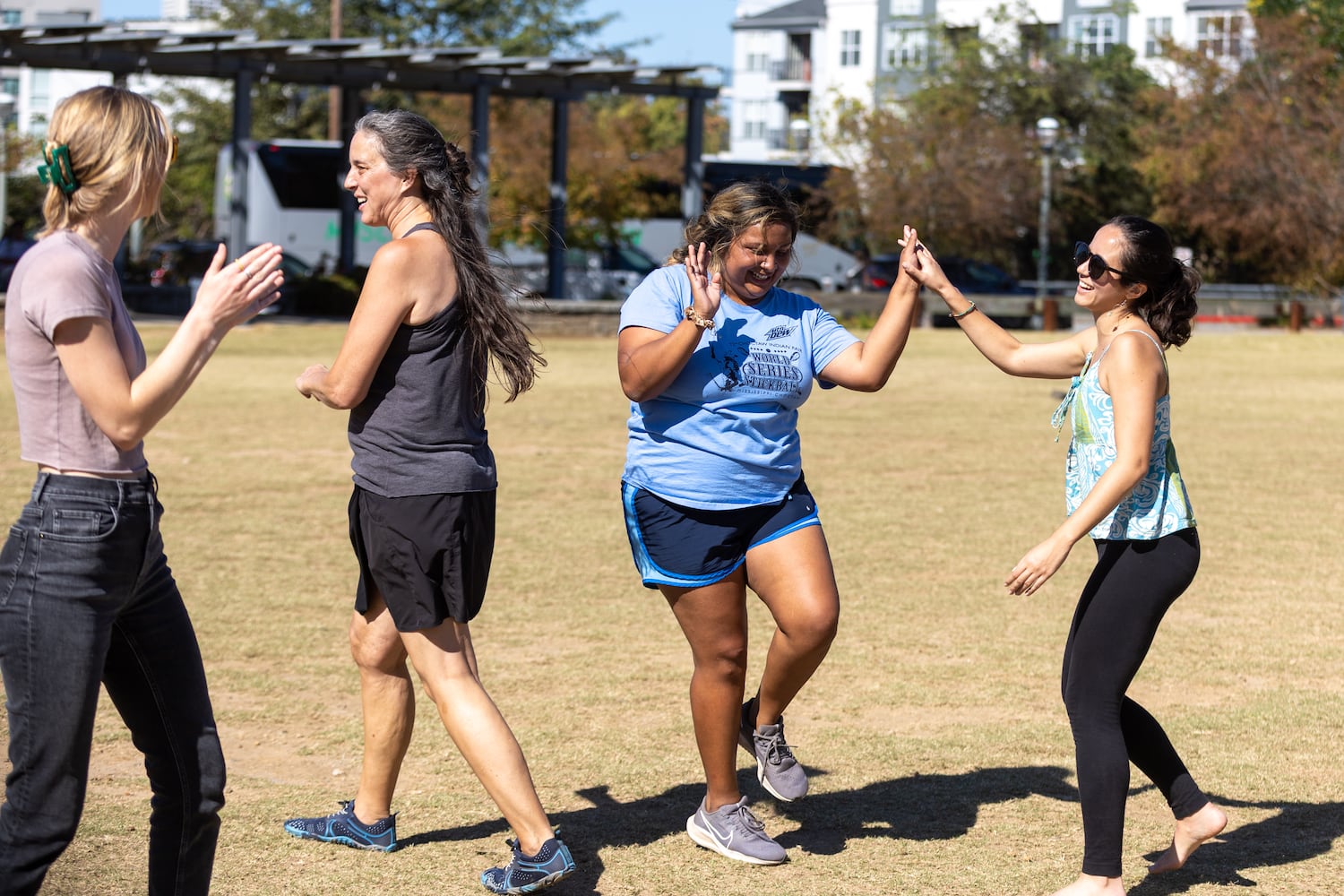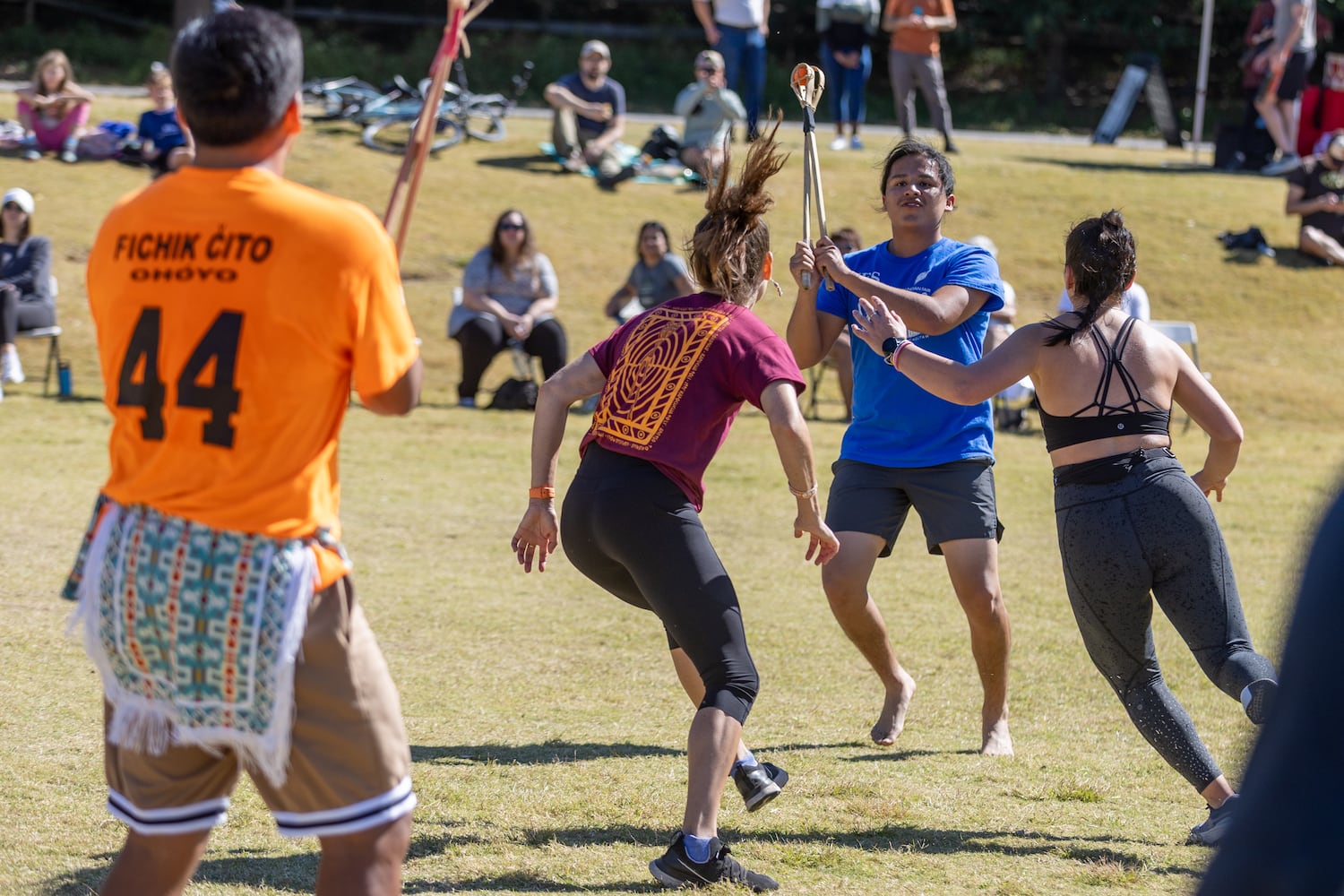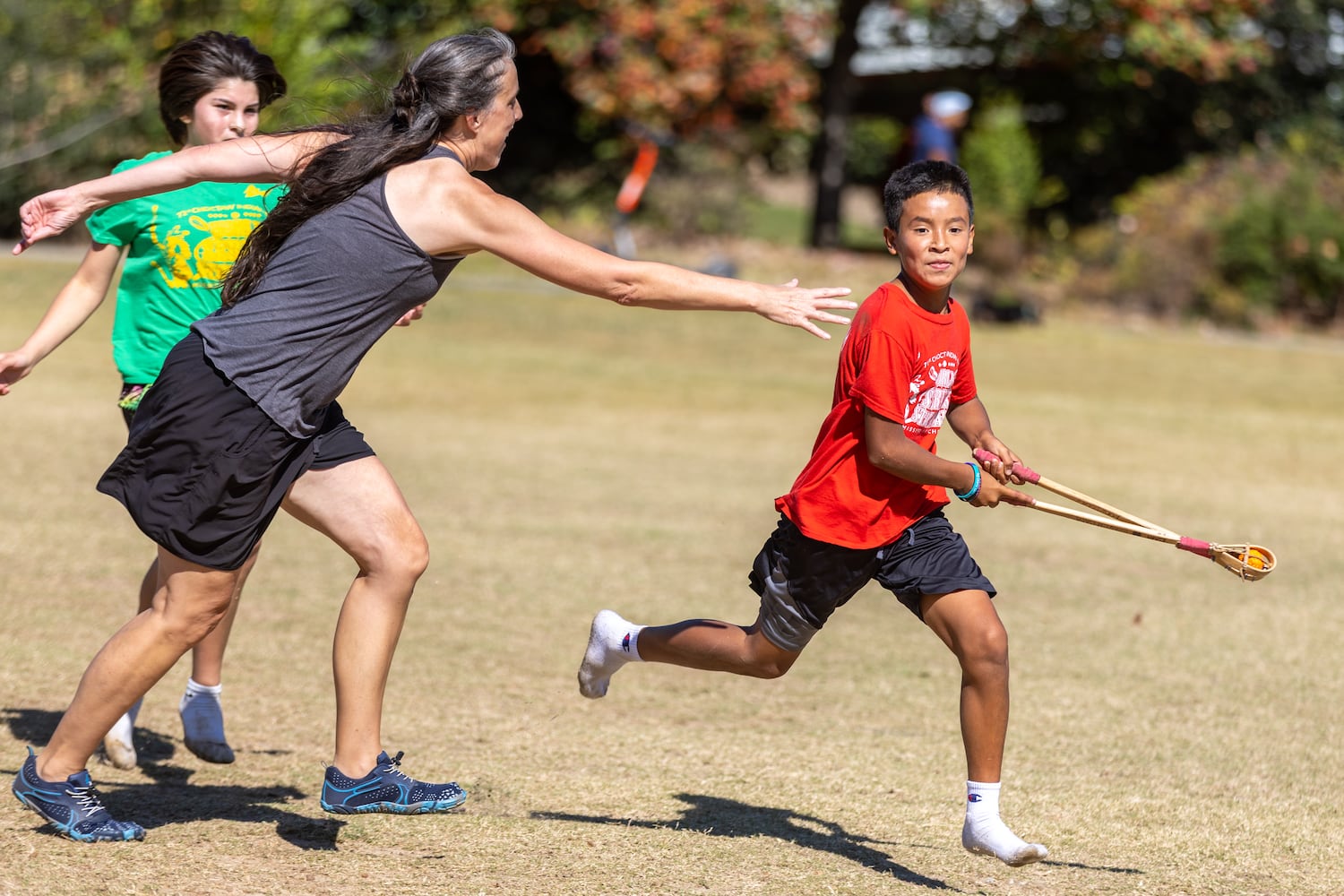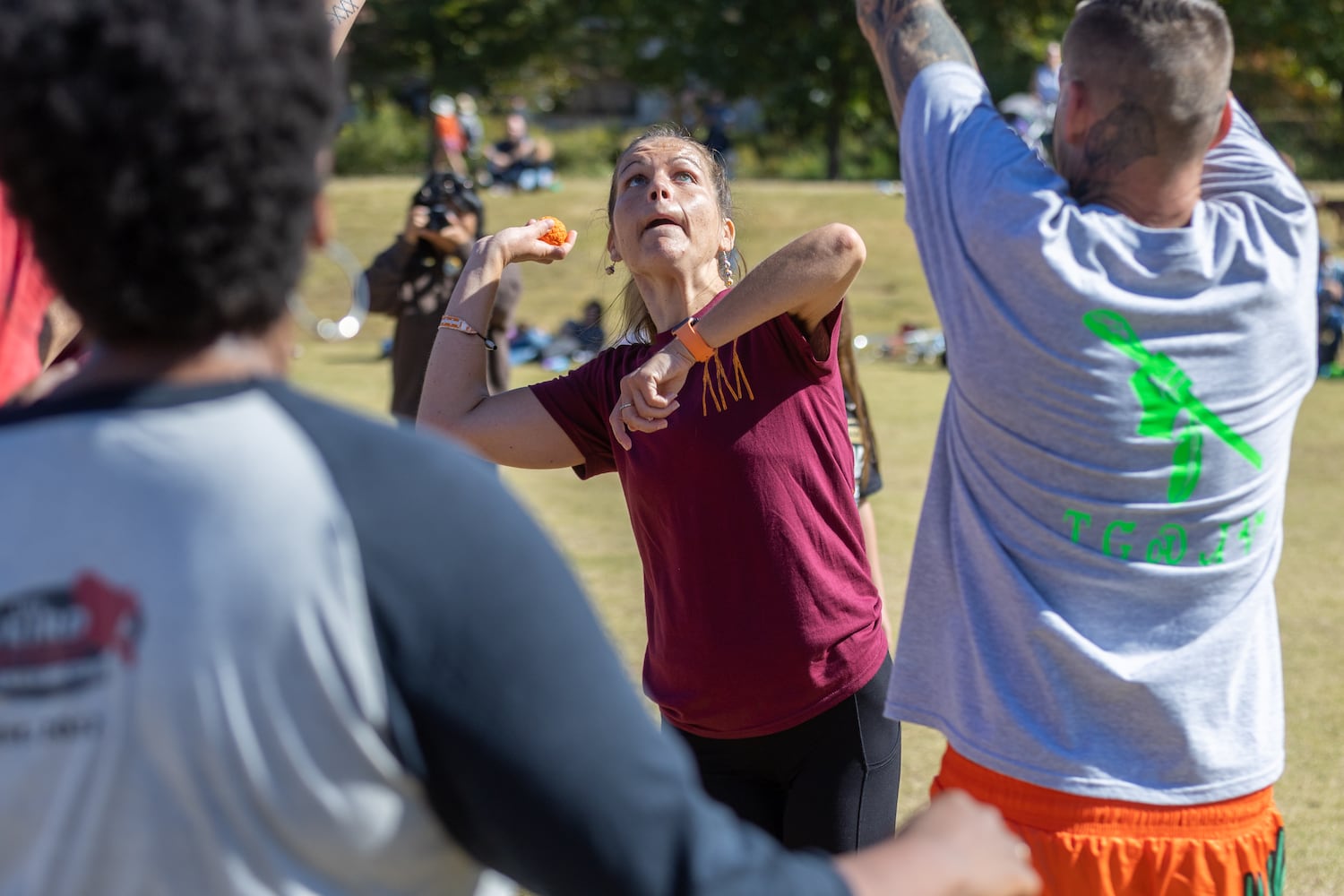Ryker Sixkiller did not have to pretend much when he stepped onto the Atlanta area set for his acting role in this year’s Marvel “Echo” television series. Bare-chested, partly painted blue and wearing feathers in his long hair, the stuntman was told to portray a Cherokee athlete playing stickball against the Choctaw.
Sixkiller knew what he was doing, having competed in stickball matches since he was a boy growing up in Oklahoma. It is the same sacred sport his Cherokee ancestors played in Georgia before their forced removal in the 1830s, a deadly ordeal known as the Trail of Tears.
Featuring a Choctaw superhero who is deaf, the Disney+ series is part of a renewed focus on Native American culture and history by Hollywood, museums, artists and educators. In Georgia, stickball is drawing a bright spotlight.
Last year, the state’s professional indoor lacrosse team, the Georgia Swarm, helped organize a demonstration of the sport with Native American athletes in Cherokee County. The year before that, similar exhibition games were played near Atlanta’s Beltline, which features a prominent sculpture honoring the sport. A related summit focusing on the game is in the planning stages for next year.
Sixkiller is especially grateful his two young sons can watch him play the game in a historically accurate way. The filmmakers consulted Native American experts, built an authentic village south of Atlanta and hired other stickball athletes to appear in Episode 2 of “Echo.”
“Every one of our ancestors fought for us to be here and fought for this game to still be alive because it could have died along with a lot of the culture,” said the 32-year-old Sixkiller, who has also landed roles in “Reservation Dogs” and “Killers of the Flower Moon” and is a cinematographer for Cherokee Film. “They held on to this game. That is how important it was.”
Credit: Courtesy of Ryker Sixkiller
Credit: Courtesy of Ryker Sixkiller
The bat and the flying squirrel
Similar to modern day lacrosse, stickball was originally played to resolve disputes between Native Americans, to keep them in shape and to prepare them for war. It is considered ceremonial and spiritual.
The contact sport involves opposing teams attempting to outscore each other, using short wooden sticks with pockets designed to carry a ball. The rules and field dimensions vary from Native American nation to nation and match to match. Tackling is legal in some versions. Today, teams compete in an annual world series event in Mississippi.
Men and women play stickball. The same is true for lacrosse. But unlike stickball athletes, male and female lacrosse competitors carry longer sticks. And male lacrosse players wear helmets and pads.
Credit: Kyle Hess/Georgia Swarm
Credit: Kyle Hess/Georgia Swarm
Both sports share a fable that highlights a greater message behind the games: One day, a bear, a deer and a turtle challenged an eagle, a hawk and other birds to a stickball match. Two small furry, wingless creatures hardly larger than mice asked the birds if they could join their team, saying the other four-legged animals had laughingly rejected them because of their size.
Taking pity on them, the birds stretched out the fur of one of the diminutive newcomers, transforming it into a flying squirrel. The birds also cut some leather off a drum and fashioned wings for their other new teammate, turning it into a bat.
As they practiced, the birds noticed the bat circled and never let the ball hit the ground. They saw the flying squirrel spring off a limb, catch the ball in its teeth and carry it to another treetop a hundred feet away. The birds realized they had gained skillful allies.
The game began. The flying squirrel caught the ball and carried it up a tree before throwing it to the birds. They dropped it to the bat, who dodged with it and scored a goal, winning the game. The message: Every creature can contribute, no matter how great or small.
James Mooney, an ethnographer who lived among the Cherokee, included a version of this story in an article he wrote about stickball for American Anthropologist in 1890. Mooney was struck by the sacred rituals and elaborate rules the Cherokee attached to the sport, as well as its roughness.
“Almost everything short of murder is allowable in the game,” wrote Mooney, who worked for the Smithsonian’s Bureau of American Ethnology. “Serious accidents are common. In the last game which I witnessed one man was seized around the waist by a powerfully built adversary, raised up in the air and hurled down upon the ground with such force as to break his collarbone. His friends pulled him out to one side and the game went on.”
When rival Native American settlements in Georgia played a game of stickball near what is now Jasper in 1834, Mooney wrote, their chiefs wagered money on the outcome.
W. Jeff Bishop, who leads Reinhardt University’s Funk Heritage Center in Waleska, has gathered other written accounts of stickball in Georgia. Among them is an Atlanta Constitution article published in 1889 that says James Simmons, an 85-year-old justice of the peace from Pickens County, witnessed a match between the Talona and Sharp Mountain settlements. The athletes, the article says, “got many bruises but they never flinched till the end.”
Bishop recently led a visitor on a tour of his museum, highlighting a small exhibit that features two stickball sticks.
“We do know,” he said, “that there were versions of stickball played all over the North American continent.”
Legends of Lax
Kathi Littlejohn, an Eastern Band of Cherokee Indians historian, has noticed renewed interest in stickball in Georgia and where she resides in Cherokee, North Carolina.
Her community holds an annual fair in the fall featuring many stickball games across four days for boys, teens and adults. Spectators, she said, arrive early to stake out good spots on the sidelines. Last year, she traveled to Ball Ground in Georgia’s Cherokee County to watch athletes from her community compete in an exhibition game.
“In the last 10 or 15 years, there has been a real resurgence of interest,” she said. “It is so exciting for us to see it coming back.”
Credit: Kyle Hess/Georgia Swarm
Credit: Kyle Hess/Georgia Swarm
The teams demonstrated the sport in Ball Ground as part of an event organized with the Georgia Swarm, a professional indoor lacrosse team that competes in the Gas South Arena in Duluth.
The Swarm’s roster features top Native American lacrosse athletes, including one of the greatest in the world, Lyle Thompson of the Onondaga Nation. While competing for the University at Albany in New York, Thompson was twice awarded the Tewaaraton Award, lacrosse’s equivalent of football’s Heisman Trophy.
Credit: Kyle Hess/Georgia Swarm
Credit: Kyle Hess/Georgia Swarm
Thompson appears on the cover of a new Marvel comic book that features the story about the bat and the flying squirrel. Called “Legends of Lax,” the comic book will be given away to fans under 18 at the Swarm’s April 19 Marvel Super Hero Night, when Thompson’s team will take on the Rochester Nighthawks.
Credit: Courtesy of the Georgia Swarm
Credit: Courtesy of the Georgia Swarm
The comic book also tells the story of a French missionary named Jean de Brébeuf, who observed a version of stickball in the 17th century when he was living among the Huron in what is now Canada. He wrote about it as part of “Relations des Jésuites de la Nouvelle-France,” a series of annual dispatches from Jesuit missions in North America.
Brébeuf, who was canonized many years later, is credited with coining the name “lacrosse,” as he reportedly compared the wooden sticks the Huron wielded to croziers, or the hooked staffs carried by bishops. The Huron, he wrote in 1636, believed lacrosse had healing powers. That is why some Native Americans today call it “the Medicine Game.”
“Imagine a poor sick person, fevered of body and almost dying, and some miserable sorcerer prescribes, as a cooling remedy, a game of lacrosse!” Brébeuf wrote.
“Or perhaps the patient himself has dreamed that he must die unless the whole country plays lacrosse for his health. Then, no matter how insignificant the person may be, you will see a fine field where village contends against village for lacrosse supremacy, with wagers of beaver robes and beaded necklaces spurring them on.”
Lacrosse is now played at high schools and colleges across Georgia and the United States and in dozens of other countries. Last included in the Olympic Games as a demonstration sport in London in 1948, it is set to return to the Olympic stage in 2028 in Los Angeles.
Little Brother of War
Just off Atlanta’s Beltline near the Historic Fourth Ward Skatepark rises a sculpture depicting a pair of six-foot-long stickball sticks. Called “Little Brother of War,” the Chickasaw name for stickball, the artwork was cast in iron, though it was crafted to resemble wood.
Its Chickasaw and Choctaw creator, Addison Karl, calls its turquoise-colored patina an ode to his maternal grandfather, who kept a pair of sticks on display in his home in Arizona. A friend pointed out to Karl that his grandfather’s sticks were actually of Muscogee design. That turned out to be fitting for his sculpture, Karl said, since the Muscogee lived in Georgia before their forced removal.
“After my grandfather passed away and became an ancestor, luckily out of my two brothers I ended up getting his sticks and have had them with me ever since,” he said. “It was something really special for him. And it was something special for us, too, as kids growing up. It connected us to the Southeast, even though we grew up in the Southwest.”
Credit: Courtesy of Addison Karl
Credit: Courtesy of Addison Karl
After his sculpture was installed a few years ago, Karl joined Atlanta BeltLine Inc. and Emory University in organizing a stickball conference in the city. The 2022 event featured an opening ceremony, a panel discussion with Native American stickball athletes and exhibition games at the Historic Fourth Ward Park. Planning is underway for a related event for next year.
Among those who participated in the summit in 2022 was Monte Randall, a stickball athlete who leads the College of the Muscogee Nation in Oklahoma. He brought some of his college’s faculty and students with him to the event in Georgia.
“It is really emotional,” he said, “to see elements of our culture back in our homelands.”
Sixkiller, the Cherokee actor and stuntman, also described his experience in Georgia as emotional. He remembered meeting fellow Muscogee and Choctaw stickball athletes on the “Echo” set. Once the filming was complete, he said, they stuck around and kept playing the sport they love.
“When we actually got to go all out and play how we normally play, it was just the best time,” Sixkiller said. “I was on a high the whole time. All of us were. The energy was just through the roof. It was nonstop. People were going 100% and having a good time. We were all constantly laughing and motivated to keep going harder.”
Credit: Courtesy of Ryker Sixkiller
Credit: Courtesy of Ryker Sixkiller
About the author
Jeremy Redmon has played, coached and officiated lacrosse for many years and has written about the sport for The Atlanta Journal-Constitution, USA Lacrosse Magazine and Inside Lacrosse.
About the Author
Keep Reading
The Latest
Featured

